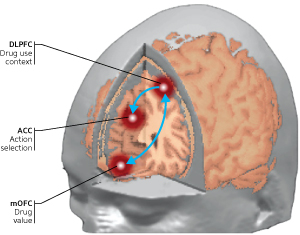May 2, 2013 Research Highlight Biology
Controlling the cravings
Aberrant frontal circuitry controls smokers’ craving for cigarettes
 Figure 1: Interactions between the dorsolateral prefrontal cortex (DLPFC) and orbitofrontal cortex (OFC) control cigarette craving. © 2013 Takuya Hayashi, RIKEN Center for Life Science Technologies
Figure 1: Interactions between the dorsolateral prefrontal cortex (DLPFC) and orbitofrontal cortex (OFC) control cigarette craving. © 2013 Takuya Hayashi, RIKEN Center for Life Science Technologies
Drug addiction alters the brain’s reward system, leading users to place great value in the drugs and seek them out. In ex-addicts, drug-related cues such as the sight of paraphernalia trigger cravings that can lead to relapse. Craving is known to be controlled by the frontal cortex, but exactly how and the areas involved remain unclear. New research led by Takuya Hayashi of the RIKEN Center for Life Science Technologies and Alain Dagher of the Montreal Neurological Institute at McGill University, Canada, has now identified two distinct regions of the frontal cortex that interact to regulate smokers’ cravings for cigarettes1.
The team recruited ten smokers and used functional magnetic resonance imaging (fMRI) to indirectly measure their brain activity while watching film clips of people smoking. On one occasion, the participants were told before the fMRI scan that they could have a cigarette immediately after the scan, and on the other, they were told that they would have to wait four hours before smoking again.
Previously, greater craving-related activity had been shown to occur in the dorsolateral prefrontal cortex (DLPFC) in smokers who were told they can smoke immediately after being scanned. This time, the researchers used a technique called transcranial magnetic stimulation (TMS) to temporarily inactivate the DFPLC of the participants just before their scan.
Craving, as measured by the participants’ subjective reports, was stronger when they were told they could smoke immediately. In keeping with the earlier findings, the DLPFC showed greater activity when they were allowed to smoke immediately. However, the researchers also found that craving was represented by activity in another region called the medial orbitofrontal cortex (mOFC), which assigns value to available stimuli and actions.
Inactivation of the DLPFC eliminated the subjective reports of stronger craving when participants had been told they could smoke immediately afterwards, and also attenuated the value-related activity of the mOFC and another region known as the anterior cingulate cortex—an area related to transforming value into action (Fig. 1).
The findings suggest that the DLPFC drives decisions about drug seeking based on knowledge of drug availability, and that aberrant frontal circuitry may underlie the pathology of addiction.
“This tells us that addiction is a decision-making problem that may be due to aberrant circuitry in frontal regions,” says Hayashi. “Some researchers have been testing the use of TMS of the DLPFC to treat addiction, but the effects are controversial. The study identified the pin-point frontal location that modulates craving.”
References
- 1. Hayashi, T., Ko, J.H., Strafella, A.P., Dagher, A. Dorsolateral prefrontal and orbitofrontal cortex interactions during self-control of cigarette craving. Proceedings of the National Academy of Sciences USA 110, 4422–4427 (2013). doi: 10.1073/pnas.1212185110
